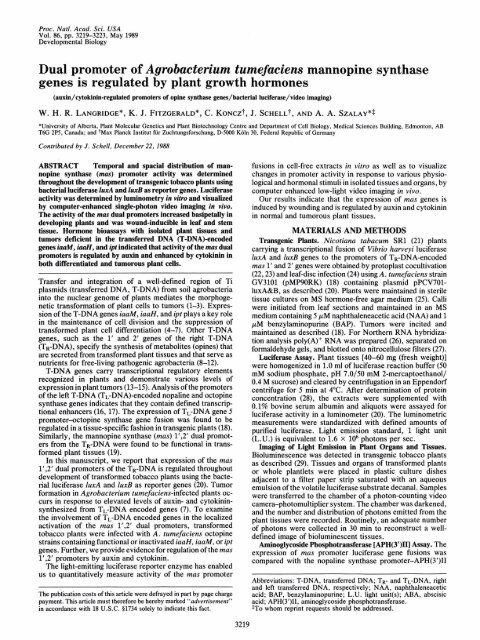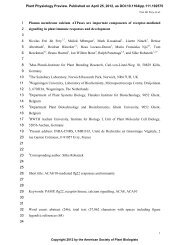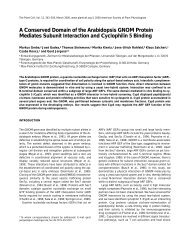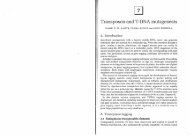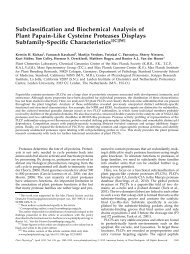Dual promoter of Agrobacterium tumefaciens mannopine synthase ...
Dual promoter of Agrobacterium tumefaciens mannopine synthase ...
Dual promoter of Agrobacterium tumefaciens mannopine synthase ...
You also want an ePaper? Increase the reach of your titles
YUMPU automatically turns print PDFs into web optimized ePapers that Google loves.
Proc. Natl. Acad. Sci. USAVol. 86, pp. 3219:3223, May 1989Developmental Biology<strong>Dual</strong> <strong>promoter</strong> <strong>of</strong> <strong>Agrobacterium</strong> <strong>tumefaciens</strong> <strong>mannopine</strong> <strong>synthase</strong>genes is regulated by plant growth hormones(auxin/cytokinin-regulated <strong>promoter</strong>s <strong>of</strong> opine <strong>synthase</strong> genes/bacterial luciferase/video imaging)'University <strong>of</strong> Alberta, Plant Molecular Genetics and Plant Biotechnology Centre and Department <strong>of</strong> Cell Biology. Medical Sciences Building. Edmonton, ABT6G 2P5, Canada; and ax Planck Institut fiir Zuchtungsforschung, DSOOO Koln 30, Federal Republic <strong>of</strong> GermanyContributed by J. Schell, December 22, 1988ABSTRACT Temporal and spacial distribution <strong>of</strong> <strong>mannopine</strong><strong>synthase</strong> (mar) <strong>promoter</strong> activity was determinedthroughout the development <strong>of</strong> transgenic tobacco plants usingbacterial luciferase luxA and luxB as reporter genes. Luciferaseactivity was determined by luminometry in vifm and visualizedby computer-enhanced single-photon video imaging in vivo.The activity <strong>of</strong> the mas dual <strong>promoter</strong>s increased basipetally indeveloping plants and was wound-inducible in leaf and stemtissue. Hormone bioassays with isolated plant tissues andtumors deficient in the transferred DNA (T-DNA)-encodedgenes iaaM, W, and ipt indicated that activity <strong>of</strong> the mas dual<strong>promoter</strong>s is regulated by auxin and enhanced by cytokinin inboth differentiated and tumorous plant cells.Transfer and integration <strong>of</strong> a well-defined region <strong>of</strong> Tiplasmids (transferred DNA, T-DNA) from soil agrobacteriainto the nuclear genome <strong>of</strong> plants mediates the morphogenetictransformation <strong>of</strong> plant cells to tumors (1-3). Expression<strong>of</strong> the T-DNA genes iaaM, iaaH, and ipt plays a key rolein the maintenance <strong>of</strong> cell division and the suppression <strong>of</strong>transformed plant cell differentiation (4-7). Other T-DNAgenes, such as the 1' and 2' genes <strong>of</strong> the right T-DNA(TR-DNA), specify the synthesis <strong>of</strong> metabolites (opines) thatare secreted from transformed plant tissues and that serve asnutrients for free-living pathogenic agrobacteria (8-12).T-DNA genes cany transcriptional regulatory elementsrecognized in plants and demonstrate various levels <strong>of</strong>expression in plant tumors (13-15). Analysis <strong>of</strong> the <strong>promoter</strong>s<strong>of</strong> the left T-DNA (TL-DNA)-encoded nopaline and octopine<strong>synthase</strong> genes indicates that they contain defined transcriptionalenhancers (16, 17). The expression <strong>of</strong> TL-DNA gene 5<strong>promoter</strong>-octopine <strong>synthase</strong> gene fusion was found to beregulated in a tissue-specific fashion in transgenic plants (18).Similarly, the <strong>mannopine</strong> <strong>synthase</strong> (mas) 11,2' dual <strong>promoter</strong>sfrom the TR-DNA were found to be functional in transformedplant tissues (19).In this manuscript, we report that expression <strong>of</strong> the mas11,2' dual <strong>promoter</strong>s <strong>of</strong> the TR-DNA is regulated throughoutdevelopment <strong>of</strong> transformed tobacco plants using the bacterialluciferase luxA and luxB as reporter genes (20). Tumorformation in <strong>Agrobacterium</strong> <strong>tumefaciens</strong>-infected plants occursin response to elevated levels <strong>of</strong> auxin- and cytokininsynthesizedfrom TcDNA encoded genes (7). To examinethe involvement <strong>of</strong> TL-DNA encoded genes in the localizedactivation <strong>of</strong> the mas 11,2' dual <strong>promoter</strong>s, transformedtobacco plants were infected with A. <strong>tumefaciens</strong> octopinestrains containing functional or inactivated iaaH, iaaM, or iptgenes. Further, we provide evidence for regulation <strong>of</strong> the mas11,2' <strong>promoter</strong>s by auxin and cytokinin.The light-emitting luciferase reporter enzyme has enabledus to quantitatively measure activity <strong>of</strong> the mas <strong>promoter</strong>The costs <strong>of</strong> this article were defrayed in part by page chargepayment. This article must therefore be hereby marked "advertisement"in accordance with 18 U.S.C. 01734 solely to indicate this fact.fusions in cell-free extracts in vitro as well as to visualizechanges in <strong>promoter</strong> activity in response to various physiologicaland hormonal stimuli in isolated tissues and organs, bycomputer enhanced low-light video imaging in vivo.Our results indicate that the expression <strong>of</strong> mas genes isinduced by wounding and is regulated by auxin and cytokininin normal and tumorous plant tissues.MATERIALS AND METHODSTransgenic Plants. Nicotiana tabacum SR1 (21) plantscarrying a transcriptional fusion <strong>of</strong> Vibrio harveyi luciferaseluxA and luB genes to the <strong>promoter</strong>s <strong>of</strong> TR-DNA-encodedmas 1' and 2' genes were obtained by protoplast cocultivation(22,23) and leaf-disc infection (24) using A. <strong>tumefaciens</strong> strainGV3101 (pMP90RK) (18) containing plasmid pPCV701-luxA&B, as described (20). Plants were maintained in steriletissue cultures on MS hormone-free agar medium (25). Calliwere initiated from leaf sections and maintained in an MSmedium containing 5 pM naphthaleneacetic acid (NAA) and 1pM benzylaminopurine (BAP). Tumors were incited andmaintained as described (18). For Northern RNA hybridizationanalysis poly(A)+ RNA was prepared (26), separated onformaldehyde gels, and blotted onto nitrocellulose filters (27).Luciferase Assay. Plant tissues [40-60 mg (fresh weight)]were homogenized in 1.0 ml <strong>of</strong> luciferase reaction buffer (50mM sodium phosphate, pH 7.0150 mM 2-mercaptoethanol/0.4 M sucrose) and cleared by centrifugation in an Eppendorfcentrifuge for 5 min at 4°C. After determination <strong>of</strong> proteinconcentration (28), the extracts were supplemented with0.1% bovine serum albumin and aliquots were assayed forluciferase activity in a luminometer (20). The luminometricmeasurements were standardized with defined amounts <strong>of</strong>purified luciferase. Light emission standard, 1 light unit(L.U.) is equivalent to 1.6 x lo6 photons per sec.Imaging <strong>of</strong> Lit Emission in Plant Organs and Tissues.Bioluminescence was detected in transgenic tobacco plantsas described (29). Tissues and organs <strong>of</strong> transformed plantsor whole plantlets were placed in plastic culture dishesadjacent to a filter paper strip saturated with an aqueousemulsion <strong>of</strong> the volatile luciferase substrate decanal. Sampleswere transferred to the chamber <strong>of</strong> a photon-counting videocamera-photomultiplier system. The chamber was darkened,and the number and distribution <strong>of</strong> photons emitted from theplant tissues were recorded. Routinely, an adequate number<strong>of</strong> photons were collected in 30 min to reconstruct a welldefinedimage <strong>of</strong> bioluminescent tissues.Aminoglycoside Phosphotransferase [APH(3')II] Assay. Theexpression <strong>of</strong> mas <strong>promoter</strong> luciferase gene fusions wascompared with the nopaline <strong>synthase</strong> <strong>promoter</strong>-APH(3')IIAbbreviations: T-DNA, transferred DNA; TR- and TL-DNA, rightand left transferred DNA, respectively; NAA, naphthaleneaceticacid; BAP, benzylaminopurine; L.U. light unit(s); ABA, abscisicacid; APH(3')II, aminoglycoside phosphotransferase.*TO whom reprint requests should be addressed.
3220 Developmental Biology: Langridge et al.gene fusion contained in pPCV7OlluxABiB T-DNA, as internalstandard. Tissue extracts were prepared as described (18)and assayed for APH(3')II activity using kanamycin sulfateand [y-32P]ATP substrates (19). In samples containing identicalamounts <strong>of</strong> protein, the relative activity <strong>of</strong> APH(3')IIenzyme was determined by densitometric scanning <strong>of</strong> kanamycinphosphate spots on autoradiograms.RESULTSTissue Specificity <strong>of</strong> mas Promoters. The mas genes aretranscribed from closely linked mas 1' and 2' dual <strong>promoter</strong>s<strong>of</strong> the TR-DNA (19). To study regulation <strong>of</strong> the mas <strong>promoter</strong>s,luciferase was used as a reporter system. The luxA andIuxB genes encoding a heterodimeric luciferase in Vibrioharveyi were converted to structural gene cassettes, linked tothe mas 11,2' dual <strong>promoter</strong>s in vector pPCV70lluxABiB (20),and transformed into tobacco plants. We have reported (20)that the expression <strong>of</strong> mas <strong>promoter</strong>-fused luciferase genesresults in synthesis and assembly <strong>of</strong> a functional luciferaseenzyme, conferring light emission in plants. Quantitativetranscript analysis demonstrated that similar amounts <strong>of</strong> luxAand luxB transcripts were synthesized from the mas 1' and 2'<strong>promoter</strong>s in transformed plant tissues (Fig. l), indicatingthat sequences located in a 200-base-pair region between the1' and 2' <strong>promoter</strong>s, regulate bidirectional transcription.Thus, luciferase activity may reflect changes in transcriptionalactivity <strong>of</strong> both mas <strong>promoter</strong>s.The luciferase reporter gene system has provided a sensitivetool to identify temporal and spacial activity <strong>of</strong> the mas<strong>promoter</strong>s in cell cultures and differentiated plants. Comparablequantitative data were obtained by in vitro luminometricdetermination <strong>of</strong> light emission in cell-free extracts preparedfrom calli, plantlets, and the tissues <strong>of</strong> vegetative andflowering plants (Table 1). Activity <strong>of</strong> the mas <strong>promoter</strong>s wasalso monitored throughout the ontogeny <strong>of</strong> transgenic plants.Calli were induced from leaves <strong>of</strong> transformed plants andregenerated to flowering plants. Light emission from tissueswas measured during each stage <strong>of</strong> development by luminometryand computer-enhanced video imaging.Calli maintained at a high auxin to cytokinin ratio displayed2200-fold higher activities than differentiated plant tissues(Table 1). At low auxin to cytokinin ratios, calli formed shootsand the activity <strong>of</strong> the mas <strong>promoter</strong>s decreased. In seedderivedplantlets, luciferase was expressed in roots at muchhigher levels than in other organs. Shoot tips <strong>of</strong> soil-grownplants displayed the lowest activity when compared with othertissues. In stems, leaves, and petioles <strong>of</strong> nonflowering plants,a gradual increase in luciferase activity was observed from theprobe lux A lux B APH(3')llFIG. 1. , Hybridization <strong>of</strong> poly(A)+ RNA (10 pg) prepared fromleaves <strong>of</strong> transformed tobacco plants containing the mas <strong>promoter</strong>luciferase fusion to the Sal I luxA DNA fragment (A) and to theBamHI luxB DNA fragment (B) <strong>of</strong> pPCV70lluxABtB DNA, used asprobes. Hybridization <strong>of</strong> APH (3')II DNA probe, isolated as a Bcl I-BamHI fragment from plasmid pPCV002 DNA (18), to the plantpoly(A)+ RNA sample is shown (0. Identical amounts <strong>of</strong> DNAfragments we%e labeled and probes with similar specific activitieswere used for hybridization (18). The numbers at the left <strong>of</strong> each laneindicate the size <strong>of</strong> the hybridizing RNA in bases.Proc. Natl. Acad. Sci. USA 86 (1989)Table 1. Differential expression <strong>of</strong> mas <strong>promoter</strong> drivenluciferase reporter genes in transgenic tobacco plantsLuciferaseLuciferaseactivity,activity,L.U./pg <strong>of</strong>L.U./pg <strong>of</strong>Organ/tissue protein Organltissue proteinCallus 63.3 Flower (corolla) 0.14PlantletPetalShoot 0.04 Tip 5.4Root 7.9 Middle 1.2Leaf (stem location) Base 0.6TOP 0.06 Sepal 0.24Middle 0.10 Stamen 0.37Bottom 1.3 Anther 0.7Leaf (basal) Filament 0.6Tip 1.7 PollenMiddle 0.6 Germinated 22.2Base 0.3 Ungerminated 0.0Stem (internodes) Pistil 0.82Top (2nd) 0.12 Stigma 9.4Middle (6th) 0.35 Style 1.2Bottom (13th) 1.27 ovary 0.1Stem sectionEpidermis 0.12Vascular tissue 1.31Pith 0.33Root tip 51.7Nicotiana tabacum cv. Petit Havana SR1 leaf discs (7 mm) wereinfected with A. turnefaciens containing the bacterial luciferase plantexpression vector pPCV7OlluxA&B. Leaf discs were transferred toMS medium containing NAA (0.1 mg/liter), BAP (0.5 mg/liter),kanamycin (100 mg/liter), and claforan (400 mg/liter). Plants wereregenerated from antibiotic-resistant calli. Luciferase activity wasmeasured in homogenates <strong>of</strong> callus, stem, and root tissue <strong>of</strong> 20,1-month-old 2-cm-tall plantlets and from flowering plants (1 m tall)grown from the seed <strong>of</strong> self-pollinated N. rabacum SR1 plants.Luciferase activity in leaf and corolla tissue was calculated based onthe average L.U. detected in three tissue discs (7 mm) from a leaf twonodes above the base <strong>of</strong> the plant or from a flower. Luciferaseactivity in stem internode sections was based on the average L.U.detected in homogenates from four serial sections taken from theninth internode below the shoot apex.shoot apex toward the base. In the stem, maximum luciferaseactivities were located in the cambium and vascular tissues.This result may reflect the high density <strong>of</strong> cells in vasculartissues. Leaves displayed a gradient <strong>of</strong> bioluminescence,resulting in a 30-fold increase in luciferase expression from theleaf base to the tip (Fig. 2B). During flowering, the basipetalexpression gradient disappeared resulting in an increased level<strong>of</strong> luciferase expression throughout all stem and leaf tissuesexamined. In flowers, 2 days prior to opening a dramaticincrease <strong>of</strong> luciferase activity was detected in nonfused portions<strong>of</strong> the corolla (Fig. 2C). A basipetal expression gradientwas also found in all flower tissues examined (Table 1). Themas <strong>promoter</strong>s were silent in pollen, but became highly activewithin the first hour <strong>of</strong> pollen germination (results not shown).A comparable distribution <strong>of</strong> luciferase activity was found inplants transformed with the fused luxAB genes linked to themas 1' or2' <strong>promoter</strong>. Fusion <strong>of</strong> the luxA and -B genes resultedin the expression <strong>of</strong> a 78-kDa single bacterial luciferasepolypeptide in transformed plants (A. Escher and A. A. S.,unpublished work). The spacial distribution <strong>of</strong> nopaline <strong>synthase</strong><strong>promoter</strong>-driven APH(3')II gene activity, although displayingsome variability in plant tissues, differed in pattern andlevel <strong>of</strong> expression from the described activity <strong>of</strong> the mas<strong>promoter</strong> (ref, 18, data not shown).The basipetal luciferase activity gradient in plant organs,the change <strong>of</strong> reporter gene expression in calli by modification<strong>of</strong> auxin to cytokinin ratios, and alteration in the
3222 Developmental Biology: Langridge et al.apex <strong>of</strong> several transgenic plants was removed and the cutstem was treated with 10 pM NAA. This treatment resultedin a 130-fold increase in reporter enzyme activity whencompared to stem samples taken immediately after removingthe shoot apex (Table 2). Activity <strong>of</strong> the luciferase reporterenzyme also increased about 50-fold in untreated stemsections, indicating a wound-induced activation <strong>of</strong> the mas<strong>promoter</strong>s. Since the activity <strong>of</strong> the nopaline <strong>synthase</strong> <strong>promoter</strong>-drivenAPH(3')II gene increased only 3-fold, we concludedthat extracellular addition <strong>of</strong> auxin enhances expression<strong>of</strong> the mas 1',2' dual <strong>promoter</strong>-luciferase gene fusion.In stem sections obtained from the ninth internode belowthe apex, treatments with cytokinin (1 pM BAP) increasedthe wound-induced level <strong>of</strong> luciferase gene expression to=SO% <strong>of</strong> that observed when auxin (10 pM NAA) was added(Fig. 3A). In stem sections incubated with auxin, a SO-foldincrease in luciferase activity was detected. Addition <strong>of</strong>cytokinin to auxin-treated sections did not significantlyincrease the level <strong>of</strong> luciferase expression (Fig. 3A).'ro follow auxin-dependent activation <strong>of</strong> the mas <strong>promoter</strong>s,leaf discs were incubated with increasing amounts <strong>of</strong>auxin in the presence <strong>of</strong> 0.3 pM BAP. Over 25 hr, acontinuous increase <strong>of</strong> light production was detected thatcorrelated with auxin concentration and that reached maximumactivity 4-5 days after incubation <strong>of</strong> the leaf discs in MSmedium (Fig. 3B and data not shown).Induction <strong>of</strong> the mas <strong>promoter</strong>s in stem sections and leafdiscs may be due to wound-induced ethylene production.However, treatment <strong>of</strong> stem sections with the ethylenegeneratingcompound chloroethyl phosphoric acid (10 pg/ml)or with ethylene inhibitors-e.g., cobalt chloride (0.1 mM)and aminovinylglycine (0.1 mM) did not enhance or inhibitluciferase expression, when added alone or with 10 pMNAA. In contrast, stem sections incubated in the auxintransport inhibitor 1,3,5-triiodobenzoic acid applied at concentrations<strong>of</strong> 1 pM to 1 mM resulted in a 10-99% inhibition<strong>of</strong> mas <strong>promoter</strong> activity.The Apical Meristem Contains a Factor That Inhibits AuxinStimulation <strong>of</strong> mas Promoter Activity. Bioassay results indicatedthat the mas <strong>promoter</strong>s are activated by auxin. However,low reporter-enzyme activity detected in shoot tips andin young leaves known to actively synthesize auxin, contradictedthe bioassay results. Ob~ewation~ described belowprovide explanations for this apparent contradiction.Application <strong>of</strong> shoot segments (3 cm long), derived fromthe stem apex, to the upper surface <strong>of</strong> stem sections (2 mm)on filter paper saturated with 5 pM NAA, resulted in almostcomplete inhibition <strong>of</strong> luciferase expression in the stem discsmeasured 12 hr after application <strong>of</strong> the stem segment (Fig.20). This result indicates that the shoot apex produces anTable 2. Wound and auxin-mediated activation <strong>of</strong> mas <strong>promoter</strong>sin stem sections from decapitated transgenic plants- ~pp~Luciferase Fold Foldactivity, increase in APH(3')II, increase inTime, L.U./pg luciferase units/pg APH(3')IIhr Auxin <strong>of</strong> protein activity <strong>of</strong> protein activity0 - 0.5 1 3.0 024 - 24.0 48 8.5 2.872 - 33.0 66 - -0 + 1.4 1 4.5 024 + 187.0 134 16.4 3.672 + 204.0 146 6.1 1.4Nonflowering 1.0-m-tall tobacco plants were decapitated in themiddle <strong>of</strong> the 10th internode below the shoot apex and the stem wasencased in a Tygon tubing sleeve to form a well. The cut stem surfacewas treated with water or 10 pM NAA. Enzyme activities wereassayed in homogenates <strong>of</strong> 4-mm-thick stem sections excised atselected time intervals.Proc. Natl. Acad. Sci. USA 86 (1989)0 10 20 30 40 50Time (hr)Time (hr)FIG. 3. (A) Influence <strong>of</strong> auxin and cytokinin on mas <strong>promoter</strong>activity in stem sections. Sections excised 10-12 internodes belowthe shoot apex <strong>of</strong> nonflowering plants were incubated on filter paperdiscs saturated with water (A); 1 pM BAP (e); 10pM NAA (u); 1 pMBAP and 10 pM NAA (A); or a mixture <strong>of</strong> 1 pM BAP, 10 pM NAA,and cycloheximide at 5.0 pg/ml (0). At selected time intervals, stemslices were homogenized and assayed for luciferase activity. (B)Auxin activation <strong>of</strong> mas <strong>promoter</strong>s in leaf discs. Discs (7 mm) wereexcised from a young fully expanded leaf and incubated on filterpaper saturated with a solution <strong>of</strong> 0.3 pM BAP (A) or BAPsupplemented with: 0.5 pM NAA (o), 5 pM NAA (e), 0r40pM NAA(0). Luciferase activity was measured by luminometric assay.inhibitory substance that is probably transported basipetallyin the stem and that down-regulates the dual mas <strong>promoter</strong>sby counteracting auxin stimulation.Conversion <strong>of</strong> leaf tissues to protoplasts resulted in a500-fold increase in mas <strong>promoter</strong> activity, independent <strong>of</strong>hormone concentration, during protoplast isolation. Whenprotoplast cultures were allowed to form calli, luciferaseactivity was similar to that detected in calli derived fromorgan explants. The extent <strong>of</strong> mas <strong>promoter</strong> activation due toprotoplast formation clearly exceeded the wound-inducedresponse, indicating that an inhibitor was removed from leaftissues by the protoplast isolation procedure.Within 12 hr after removal <strong>of</strong> the shoot apex in nonfloweringplants, the light emission <strong>of</strong> axillary buds increaseddramatically (Fig. 20. This result indicates that either auxinconcentration is increased in axillary buds or that an inhibitoris removed in the absence <strong>of</strong> apical dominance.Comparison <strong>of</strong> these results with models that explain themechanism <strong>of</strong> apical dominance (31) and inhibition <strong>of</strong> auxinaction (30), we have found a correlation between the obsewedphysiological properties <strong>of</strong> the putative inhibitor andabscisic acid (ABA). Treatments <strong>of</strong> auxin-activated stemsections with 10 pM to 1 mM ABA resulted in a 22-67%inhibition <strong>of</strong> mas <strong>promoter</strong> activity, respectively. Whetherthe inhibitor is identical to ABA or to other auxin-inducedABA-like compounds proposed to balance auxin action instems and leaves remains to be determined.T-DNA Genes Influence the Activity <strong>of</strong> the mas lf,2' <strong>Dual</strong>Promoters. The above observations that indicate a positiveregulatory role <strong>of</strong> exogenously provided auxin led us to studyregulation <strong>of</strong> the dual mas <strong>promoter</strong>s in tumor cells containingthe T-DNA genes iaaM, iaaH, and ipt, which specify theintracellular synthesis <strong>of</strong> auxin and cytokinin.


